4.5: Commoners
- Page ID
- 135170
Liu Bang’s first act upon taking Xianyang was to secure the empire’s population registers. As the territories of Chu, the Yue kingdoms of the southwest, and the northern peninsula were conquered, new commoners, too were registered as in Qin times, on slips of bamboo that excavations since the 1980s have been turning up. People who had to leave home to escape flood or famine were initially required to return, but from about 50 BC, Han policy encouraged them to settle down in the new location. Han also moved large groups of people to settle in newly-conquered areas. State power over land and labor was real, and local communities were being broken up.
The Qin and Han regime invested a lot of energy in fiscal and legal uniformity. But not cultural. When Qin defeated the other states, it outlawed their currencies, scripts, and laws, but the facsimiles of each palace in Xianyang symbolically incorporated them, and historian Mark Edward Lewis has argued that the glory of empire was thought to lie precisely in the variety it incorporated. The Han left local marriage and burial practices, cults, lifeways, and languages alone. Elite families shared written language, literature, and other lifeways, but as historian Charles Holcombe puts it, “The Qin and Han dynasties were both therefore significantly multicultural and multiethnic empires.”6
Most commoners faced a life of unending toil just to feed and clothe the family, and produce a little extra to buy iron and salt and other necessities. And then there were taxes. Historians disagree on how heavy the tax burden really was in the first part of the period. Land taxes were lowered from Qin rates, so that by 155 BC a farming couple paid only 1/30th of the crop, plus a tax in cloth. Each adult also owed demanding labor service – work on roads, canals, imperial tombs, and other state infrastructure; pregnant women and nursing mothers were exempt for three years. Until 31 BC, the state also demanded military service from each adult man; then the draft was commuted to a fee. Merchants without land – who throve in Han times, engaged in all kinds of trade – paid a set amount of tax per person, plus taxes on sales, and artisans paid income tax. Some argue that the state collected more than it really needed, so the emperor could improve his reputation from time to time by tax amnesties.
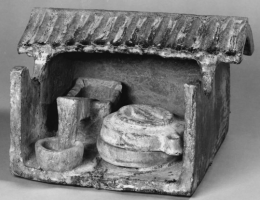 Mill: Grindstone and grain-pounder.
Mill: Grindstone and grain-pounder.
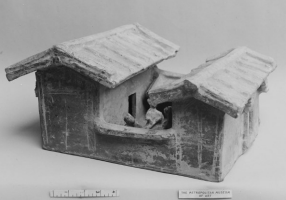 House with courtyard and people.
House with courtyard and people.
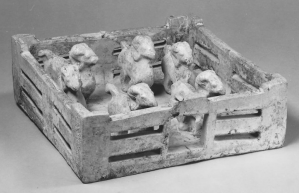 Sheep-pen with six rams.
Sheep-pen with six rams.
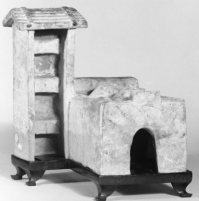 Stove with ?chimney.
Stove with ?chimney.
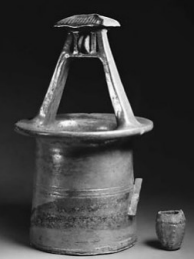 Wellhead and bucket.
Wellhead and bucket.Using that public funding, the Han state took a number of measures to support the small working families it relied on. The government provided some famine relief in times of starvation, so that farmers would not have to sell their land to survive. It provided seed grain when needed. Symbolically and ritually, the emperor signaled the importance of farming with a spring plowing ceremony, and the empress ceremonially wove to honor textile production. Magistrates honored and rewarded farmers in seasonal ceremonies, and productive farmers were granted rank in the lower rungs of the 20-rank system. Some farmers even won the right to travel on the special lane in the middle of highways that was reserved for the use of the emperor, carrying a staff with a bird on top to signal their right to be there. Officials were not permitted to demand labor during busy farming seasons. And magistrates managed public markets, so that farmers could sell extra grain or cloth or vegetables or meat and buy manufactured things they needed – salt, oil, iron tools.
Artisans, as well as contributing labor service, could earn wages in private or state workshops. Private factories made ale, processed food, leather, silk cloth, dye, lumber, pottery, bronze mirrors and other items (sometimes with fake state ‘brand names’), iron tools, carts and carriages, lacquerware dishes, etc. In state workshops, some weaving was done by men, but many artisans making luxury goods like silk and lacquer were women; the high wages supposedly made them reluctant to marry.
What do you think is going on here?
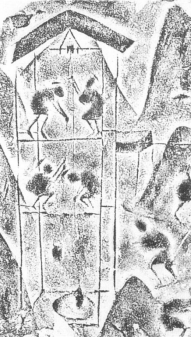
The active participation of commoners in all areas of manufacturing and the state freed up human creativity. Han inventions and developments of earlier practices included some that much later spurred the world’s creation of the modern formation of mass production based on mineral energy. We all know about paper and the north-pointing compass, but Han people also figured out, among many other things, how to drill deep into the earth for salt water (as the picture shows), pump it up into shallow pans, and make salt by piping up the natural gas in those same wells and using it to boil off the water.
The goods listed above were often made in factories where labor was divided, with each worker specializing in one stage of production. This principle was adopted by Josiah Wedgewood (1730-1795) as a cornerstone of Britain’s industrial revolution, and was made more efficient by American automobile producers through the use of the moving assembly line. The conveyor belt that made the assembly line possible was a development of another Han invention, the chain-pump used for irrigation, which was developed into a power-transmitting chain drive in Song times, and then eventually into the conveyor belt.*
Commoners indeed had great opportunities in early Han times, because of meritocracy. Men from ordinary families, if known for virtue and learning, could be recommended for office, and nobodies could rise dramatically. An example is one Gong Yu. He was a farmer who tilled 130 mou (1 mou is about .2 of an acre, but it varies a lot) of land, valued at less than 10,000 copper cash. But he also studied and earned respect for his learning, and was recommended for office. In order to pay for the trip to the capital, he had to sell all but 30 mou of his land, but his first, middle-ranking post paid 9,200 cash per month. Gong Yu won promotions until he earned 12,000 cash per month, more than the whole value of his original farm.7 Men who rose from rags to riches under Emperor Wu include a swineherd who only began to study the Classics at the age of 40, but was then selected for high office; a vagabond who worked for a general and came up with a plan for eliminating the remaining feudal kingdoms; a shepherd who earned enough money to help substantially with the Xiongnu war (see below) and was rewarded with office; and a shopkeeper’s son who was put in charge of provisioning the army. He represented the court in a famous debate with Confucians, who opposed the government monopolies on salt and iron that were funding the war. Women, too, could rise: Wudi married, and raised to primary wife and empress, a singer and dancer who was the daughter of a slave.
* Temple, The Genius of China. This book presents, with lots of pictures, some findings of the enormous multi volume project began by Joseph Needham, Science and Civilization in China, available in English and Chinese.


